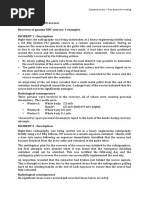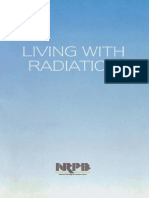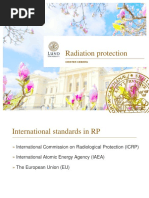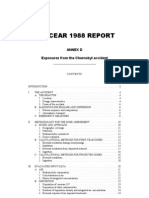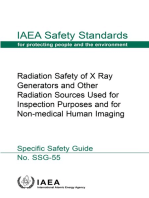Radiation
Radiation
Uploaded by
Tadesse TeshomeCopyright:
Available Formats
Radiation
Radiation
Uploaded by
Tadesse TeshomeCopyright
Available Formats
Share this document
Did you find this document useful?
Is this content inappropriate?
Copyright:
Available Formats
Radiation
Radiation
Uploaded by
Tadesse TeshomeCopyright:
Available Formats
G109:
4. Solar and Terrestrial Radiation
4. S OLAR & T ERRESTRIAL R ADIATION
P ART I:
R ADIATION
Reading Assignment:
A&B:
Ch. 2
(p. 43-53)
LM:
Lab. 5
1. Introduction
Radiation = Mode of Energy transfer
by electromagnetic waves
only mode to transfer energy without the
presence of a substance (fluid or solid)
works best in a vacuum (empty space)
Radiation = the only way for Earth to receive
energy from the Sun
Weather systems are powered by radiation
From Earth-Sun geometry we know:
spatial and temporal variations of receipt of
radiation at the top of the atmosphere
From Atmospheric Composition: important for
radiation at the surface
O3 UV radiation, shortwave
H2O & CO2 IR radiation, greenhouse, longwave
need to consider different types of radiation
Radiation.doc
9/12/03
G109:
4. Solar and Terrestrial Radiation
2. Electromagnetic Radiation
radiation waves exhibit characteristics of both electric
fields and magnetic fields
(from A&B, Figure 2-5 a)
Electromagnetic radiation moves at speed of light
radiation spreads in all directions and moves in
straight lines
(from A&B, Figure 2-9)
Radiation.doc
9/12/03
G109:
4. Solar and Terrestrial Radiation
Electromagnetic radiation is described by three
interdependent variables:
wavelength
lambda
[m, m]
frequency
nu
[s-1, Hz]
velocity
c
[m s-1]
(c = speed of light ~ 3 108 m s-1)
=c
3. Radiation Spectrum
Definition:
The Radiation Spectrum is the distribution of radiative
energy over different wavelengths, or frequencies.
In meteorology: only small part of EM-spectrum of
interest.
three important ranges:
ultraviolet radiation (UV)
visible radiation
infrared radiation (IR)
Radiation.doc
9/12/03
G109:
4. Solar and Terrestrial Radiation
Radiation in the Earth-Atmosphere System
Wavelength
Effect
Ultraviolet Radiation
UV
10-2 0.4 m
Sunburn
Class
sun output
Earth output
shortwave radiation:
longwave radiation:
Radiation.doc
Visible Radiation
0.4 0.7 m
sunlight
0.4 m
violet
blue
0.5 m
green
yellow
0.6 m
orange
0.7 m
red
Infrared Radiation
IR
0.7 100 m
heat-radiation
near IR
far IR
0.7-1.5 1.5 100
[m]
[m]
Shortwave radiation
7%
0%
43 %
0%
37 %
~0 %
only solar radiation
IR radiation emitted by the E/A-system
9/12/03
longwave
radiation
11 %
~ 100 %
G109:
4. Solar and Terrestrial Radiation
4. Radiation Laws
Read: A&B Chapter 2, p 35-39
(i)
General Principles
all things emit radiation
o the amount and wavelengths depend primarily on
the emission temperature
o higher the T faster the electrons vibrate
shorter wavelength
more total radiation emitted
when any radiation is absorbed by an object:
increase in molecular motion
increase in temperature
(ii)
Black Bodies and Gray Bodies
an object or body that absorbs all radiation incident
on it is termed a black body
idealization: perfect black bodies do not exist
often a good approximation for absorption in a
given range of wavelengths
many natural substances behave nearly like black
bodies
Radiation.doc
9/12/03
G109:
4. Solar and Terrestrial Radiation
a black body is also an ideal emitter
emission spectrum follows a general law
(Plancks curve) describing the maximum
possible emission for a given temperature
is often used as comparison standard for
emission spectrum
a black body has an ideal emission efficiency,
termed emissivity:
=1
an object or body with a less than ideal emission
efficiency (same at all wavelengths) is termed a
gray body:
a gray body has a non-ideal emission
efficiency: emissivity
<
is often a good approximation for emission
spectra of real objects or bodies
(iii) Reflection Absorption Transmission
only three things can happen, when radiation with a
wavelength, , hits an object or substance:
1. part or all can be reflected:
fraction reflected: reflectivity,
this part does not interact with the object, it is
rejected
2. part or all can be absorbed:
fraction absorbed: absorptivity, a
this part raises the temperature of the object
Radiation.doc
9/12/03
G109:
4. Solar and Terrestrial Radiation
radiative energy is converted to heat
3. part or all can be transmitted:
t
fraction transmitted: transmissivity,
this part does not interact with the object, it just
goes through it.
Since these are the only possibilities, it follows from the
principle of conservation:
+ a + t = 1
(iv) Stefan-Boltzmann Law:
the total emitted energy flux
All objects or substances emit radiation at a rate
proportional to the 4th power of their absolute
temperature
Total energy flux emitted: Ftot [W m-2] :
Ftot = T
emissivity (0 ~ 1); depends on quality of material
(see Lab Manual #5 for list of values)
Stefan-Boltzmann constant = 5.67 10-8 [W m-2 K-4]
T absolute temperature of emitting object [K]
T4 fourth power: faster than linear increase with
temperature.
Radiation.doc
9/12/03
G109:
4. Solar and Terrestrial Radiation
18000
4th power
16000
Ftot [W/m2]
14000
12000
16 x (= 2 )
10000
8000
6000
linear
4000
2x
2000
0
200
300
400
500
600
700
800
T [K]
Example Problem
(see web under this topic for more exercise problems)
If a cloud bottom has a temperature of 10 C, how much
energy would it be emitting if the emmissivity were 1.0?
Solution
convert temperature to SI-unit:
[C] [K]
T = (-10 C) + 273.15 = 263.15 K
use Stefan-Boltzmann law for = 1 (black body):
Fcloud = T4 = 1 x 5.6710-8 x (263.15)4
= 271.9 W m-2
Check units: units okay physics okay.
[T4] = [1] x [W m-2 K-4] x [K4] = [W m-2] 9
Radiation.doc
9/12/03
G109:
4. Solar and Terrestrial Radiation
(v)
Wiens Displacement Law:
the wavelength of maximum emittance
A rise of temperature in an object not only increases
the total radiant output, but also shifts this energy
output to shorter wavelengths, in inverse
proportion to the absolute temperature
Wavelength of maximum emmittance: max [m] :
max
a
= = a T 1
T
1040
1038
5800 K
4000 K
2000 K
1000 K
500 K
255 K
Te
m
pe
1036
ra
tu
1034
re
Blackbody Irradiance x [W.m-2]
max wavelength [m]
a
constant: 2898 [m K]
T
absolute temperature [K]
1032
10-7
10-6
10-5
10-4
10 -3
Wavelength [m]
Radiation.doc
9/12/03
G109:
4. Solar and Terrestrial Radiation
10
Example Problem
(see web under this topic for more exercise problems)
If a cloud bottom has a temperature of -10C what is the
wavelength of the peak energy emission? What part of
the electromagnetic spectrum is this in?
Solution
convert temperature to SI-unit:
[C] [K]
T = (-10 C) + 273.15 = 263.15 K
use Wiens law:
max = aT-1
= 2898 263.15 = 11.0 m
Check units: units okay physics okay.
[aT-1] = [mK] x [K-1] = [m] 9
Radiation.doc
9/12/03
G109:
4. Solar and Terrestrial Radiation
11
P ART II: A TMOSPHERIC I NFLUENCES
ON R ADIATION
Reading Assignment:
A&B:
Ch. 3
(p. 68-76)
LM:
Lab. 5
1. Introduction
Global Shortwave Radiation Balance (overview)
~ 30 % of solar radiation is reflected by clouds,
atmospheric gases and the surface
~ 25 % of solar radiation is absorbed by the
atmosphere (clouds, atmospheric gases, aerosol)
~ 45 % of solar radiation is absorbed by the surface
(oceans, land surface)
Influence of Clouds on Shortwave Radiation Balance
Clear conditions (no clouds):
o ~ 70 % of solar radiation is absorbed by the surface
(55% direct, 15% diffuse sky radiation)
o only ~ 13 % of solar radiation is reflected
Cloudy conditions (overcast):
o ~ 25 % of solar radiation is absorbed by the surface
sky radiation)
(4% direct,
o 51 % of solar radiation is reflected
Radiation.doc
9/12/03
G109:
4. Solar and Terrestrial Radiation
12
2. Reflection and Scattering of Radiation
Reflection: redirection of radiation by a surface
Specular Reflection
(Mirror)
Diffuse Reflection or
Scattering
Scattering by gas molecules or small particles/droplets
(from A&B, Figures 3-2, and (Phys.Princ. 2-2) 1)
Radiation.doc
9/12/03
G109:
4. Solar and Terrestrial Radiation
Blue Sky and
:
Rayleigh and
13
Scattering
(from A&B, Figure (Spec. Int. 3-1) 1)
Air Molecules tend to scatter Short Wavelengths
more, and in all directions
the blue end of the visible range
diffuse (sky) radiation appears as blue
Particles (droplets, aerosol) tend to scatter All
Wavelengths equally, and more forwards than
backwards (backscatter ~ reflection)
mixture of all wavelengths: white light
clouds, fog, haze appear as white, gray or milky
short-wave reflectance: the albedo (~ whiteness)
Radiation.doc
9/12/03
G109:
4. Solar and Terrestrial Radiation
14
3. Transmission of Radiation through the
Atmosphere
Transmission: the amount of radiation that is left,
after going through the atmosphere
(from A&B, Figure (Spec. Int. 3-1) 3)
a) At the top of the atmosphere white (sun-) light is
started to be scattered: mostly the blue portion
b) As radiation proceeds through the atmosphere, more
of the blue portion is scattered away from the direct
beam (further transmitted as diffuse radiation)
multiple scattering
c) At the surface mostly the red light is left in the
direct beam sun appears red at sunset/sunrise
Radiation.doc
9/12/03
G109:
4. Solar and Terrestrial Radiation
15
4. Absorption of Radiation in the Atmosphere
Absorption: conversion of radiation to heat
raises the temperature of the
absorbing substance
Kirchoffs law: if a substance is an efficient emitter in a
given wavelength range, it is also an
efficient absorber at the same wavelength
range:
=
Selective absorption: the absorptivities of atmospheric
gases are highly specific to certain spectral bands or
wavelength ranges
solar radiation (shortwave) absorbers:
o UV-absorbers: ozone (O3), oxygen (O2)
o visible range (0.4 - 0.7 m): almost none
(window)
terrestrial radiation (longwave) absorbers:
o IR absorbers: H2O, CO2, N2O, O3, O2
o peak terrestrial radiation (8 - 12 m):almost none
(window)
The atmosphere is transparent for solar radiation,
but nearly opaque for terrestrial radiation:
greenhouse radiation trap
Radiation.doc
9/12/03
G109:
4. Solar and Terrestrial Radiation
16
Atmospheric Windows for Radiation
Window:
something that lets light (radiation) through
Atmospheric Window: a spectral range where the
atmosphere is nearly transparent
There are two atmospheric windows:
visible range window (0.4 - 0.7 m):
lets most solar radiation through to the surface
enables solar radiation to deliver the bulk of its
energy to the surface (for use in climate processes)
longwave window (8 - 12 m):
lets some terrestrial radiation through to space
enables Earth to vent off some of its energy back to
space
(from A&B, Figure 3-6a)
Radiation.doc
9/12/03
G109:
4. Solar and Terrestrial Radiation
17
What happens if the windows are closed?
visible range window (0.4 - 0.7 m):
o increased cloud cover, and/or reflective aerosol
o increase in global albedo
o reduction of energy input into E/A system
o cooling effect
longwave window (8 - 12 m):
o increased H2O, CO2 or other greenhouse gases
o increased IR-absorption in atmosphere
o warming effect The Greenhouse Effect
(more accurately: the enhanced Greenhouse Effect)
source:
http://www.fe.doe.gov/issues/climatechange/globalclimate_whatis.html
(Jan. 22, 2001)
Radiation.doc
9/12/03
You might also like
- CS1702 Worksheet 7 - Built in Functions and Methods v1 (2022-2023)Document8 pagesCS1702 Worksheet 7 - Built in Functions and Methods v1 (2022-2023)John MoursyNo ratings yet
- C.E.D.O. Examination Knowledge Reference DocumentsDocument2 pagesC.E.D.O. Examination Knowledge Reference DocumentsFmc2No ratings yet
- Dos 514 Practice Problems 2Document8 pagesDos 514 Practice Problems 2api-210258673No ratings yet
- I-30 Recovery of Gamma NDT Sources - 3 ExamplesDocument3 pagesI-30 Recovery of Gamma NDT Sources - 3 ExamplesأحمدآلزهوNo ratings yet
- Radiation Safety AERBDocument24 pagesRadiation Safety AERBIyanar ShanmugamNo ratings yet
- 1 Origin and Nature of Nuclear RadiationDocument87 pages1 Origin and Nature of Nuclear RadiationkalioNo ratings yet
- Extra Credit Problems Submit Upto 20 QuesDocument7 pagesExtra Credit Problems Submit Upto 20 Quesapi-174496267No ratings yet
- Radiation Dose Limits: Appendix BDocument6 pagesRadiation Dose Limits: Appendix BVaradha Rajan100% (2)
- 4 PDFDocument90 pages4 PDFGopakumarNo ratings yet
- Ampicon 2019 E-Poster n0. Abs0072Document1 pageAmpicon 2019 E-Poster n0. Abs0072Jagadish JagaNo ratings yet
- Radiation Protection (Module 1.1)Document32 pagesRadiation Protection (Module 1.1)ado666eddieNo ratings yet
- Worked Out Examples For Shielding CalculationsDocument36 pagesWorked Out Examples For Shielding CalculationsJitendra DalaiNo ratings yet
- Linear Accelerator Emergency and Safety ProceduresDocument4 pagesLinear Accelerator Emergency and Safety Proceduresvanisha50% (2)
- Chapter 01 Basics Radiation PhysicsDocument194 pagesChapter 01 Basics Radiation PhysicsTya Lupheluphe Diya100% (1)
- Icrp 60Document25 pagesIcrp 60Muhammad NaveedNo ratings yet
- Nuclear Energy Agency Radiation Protection Overview - International Aspects and PerspectiveDocument11 pagesNuclear Energy Agency Radiation Protection Overview - International Aspects and PerspectiveZim VicomNo ratings yet
- Equations For Radiation SafetyDocument1 pageEquations For Radiation SafetyForeman WestermanNo ratings yet
- Biodose Models:Nsd, Cre, TDF, LQ& Their Limitations: Moderator: Mr. Ranjit Singh Presented By: Navneet KaurDocument54 pagesBiodose Models:Nsd, Cre, TDF, LQ& Their Limitations: Moderator: Mr. Ranjit Singh Presented By: Navneet KaurSAlonii ChawlaNo ratings yet
- 06 Instrumentation and Radiation Monitoring 1Document5 pages06 Instrumentation and Radiation Monitoring 1Gad ayebaleNo ratings yet
- Refresher & New User Training - 2005Document61 pagesRefresher & New User Training - 2005Abdullah Ahd. AbdulrazigNo ratings yet
- Aapm Report No. 16 Protocol For HeavyDocument60 pagesAapm Report No. 16 Protocol For HeavyLaurentiu Radoi100% (1)
- Radiation MITDocument34 pagesRadiation MITAhmedAmer1No ratings yet
- RSD 4Document12 pagesRSD 4GopakumarNo ratings yet
- Living With RadiationDocument75 pagesLiving With RadiationIkang FauziNo ratings yet
- Radioacitvity PDFDocument14 pagesRadioacitvity PDFArjun RavalNo ratings yet
- RT, RPP Exam Samble QuestionsDocument92 pagesRT, RPP Exam Samble QuestionsKartik SharmaNo ratings yet
- Discovery of RadiationDocument13 pagesDiscovery of RadiationAdel SukerNo ratings yet
- Radiation ProtectionDocument99 pagesRadiation Protectionibrahim100% (1)
- SivaDocument24 pagesSivasadaqatk74No ratings yet
- Mri Srtle .Document40 pagesMri Srtle .falhazmi0069No ratings yet
- RadioactivityDocument17 pagesRadioactivityNurasfiqah AKNo ratings yet
- Exposures From The Chernobyl Accident Annex DDocument74 pagesExposures From The Chernobyl Accident Annex DKacper SamulNo ratings yet
- Short Questions: (CHAPTER 21) Nuclear PhysicsDocument12 pagesShort Questions: (CHAPTER 21) Nuclear PhysicsEhtesham Ali KhanNo ratings yet
- Radiation Awareness Presentaion (Compatibility Mode)Document40 pagesRadiation Awareness Presentaion (Compatibility Mode)AhmedAmer1100% (1)
- 312 Ncs Report 30 Qa of Brachytherapy With AfterloadersDocument74 pages312 Ncs Report 30 Qa of Brachytherapy With AfterloadersandreymaNo ratings yet
- Radiation ProtectionDocument50 pagesRadiation ProtectionDragan Gigi100% (1)
- Atomic and Molecular Spectroscopy-2 PDFDocument60 pagesAtomic and Molecular Spectroscopy-2 PDFHaseeb HaiderNo ratings yet
- Chapter 5 Radioactivity: Writing Nuclear Reaction EquationDocument2 pagesChapter 5 Radioactivity: Writing Nuclear Reaction Equationleelee1127100% (1)
- RE ShieldingDocument32 pagesRE ShieldingWaleed TayyabNo ratings yet
- EPA Basic Rad TrainingDocument47 pagesEPA Basic Rad Trainingmark_59100% (1)
- Radiation Shielding and ProtectionDocument32 pagesRadiation Shielding and ProtectionSheryllyn Marte LindaNo ratings yet
- Radiation Safety Self-Learning PackageDocument21 pagesRadiation Safety Self-Learning PackageOana LupseNo ratings yet
- CRHPDocument4,229 pagesCRHPbcurrier10100% (1)
- Health PhysDocument7 pagesHealth PhysCarlos BustamanteNo ratings yet
- Radiography l2 NotesDocument63 pagesRadiography l2 NotesaasattiNo ratings yet
- IMPCB Requirements V10b PDFDocument35 pagesIMPCB Requirements V10b PDFHilary ChengNo ratings yet
- Ionising Radiation and Living ThingsDocument23 pagesIonising Radiation and Living ThingsMunish DograNo ratings yet
- Application For The Post of Senior Medical Physicist / RSO: A.Mohamed MusthafaDocument6 pagesApplication For The Post of Senior Medical Physicist / RSO: A.Mohamed MusthafaSrujana MNo ratings yet
- Iaea TRS 398Document179 pagesIaea TRS 398hitesh29No ratings yet
- Lesson 2 QuizDocument1 pageLesson 2 Quizjohntobler0% (1)
- NRRC SG 004Document30 pagesNRRC SG 004Ahmed shabanNo ratings yet
- Radiation Leak TestingDocument3 pagesRadiation Leak TestingTika Putri KecilNo ratings yet
- Basic Radiation BiologyDocument25 pagesBasic Radiation Biologysazaki224No ratings yet
- Radiation Safety of X Ray Generators and Other Radiation Sources Used for Inspection Purposes and for Non-medical Human Imaging: Specific Safety GuideFrom EverandRadiation Safety of X Ray Generators and Other Radiation Sources Used for Inspection Purposes and for Non-medical Human Imaging: Specific Safety GuideNo ratings yet
- Radiation Safety of Accelerator Based Radioisotope Production Facilities: Specific Safety GuideFrom EverandRadiation Safety of Accelerator Based Radioisotope Production Facilities: Specific Safety GuideNo ratings yet
- Non-ionizing Radiation Protection: Summary of Research and Policy OptionsFrom EverandNon-ionizing Radiation Protection: Summary of Research and Policy OptionsNo ratings yet
- Radiotherapy in Clinical Practice, second edition: A Pocket GuideFrom EverandRadiotherapy in Clinical Practice, second edition: A Pocket GuideNo ratings yet
- Radiation Heat TranferDocument30 pagesRadiation Heat TranferAkash MishraNo ratings yet
- HMT (U3)Document30 pagesHMT (U3)maniNo ratings yet
- Radiation Heat Transfer PDFDocument6 pagesRadiation Heat Transfer PDFعبدالمؤمن خالد محمودNo ratings yet
- Lab14A CoastalDocument6 pagesLab14A CoastalN CNo ratings yet
- MAS Assignment (Quantitative Techniques)Document3 pagesMAS Assignment (Quantitative Techniques)Angelica AllanicNo ratings yet
- Buhlmann Credibility Homework SolutionsDocument11 pagesBuhlmann Credibility Homework Solutionschitechi sarah zakiaNo ratings yet
- Elastic Theory of PlatesDocument17 pagesElastic Theory of PlatesYüksel KayaNo ratings yet
- Science 8, QUARTER 3, Activity About MatterDocument1 pageScience 8, QUARTER 3, Activity About MattercecilleNo ratings yet
- PWP Practical No. 5Document4 pagesPWP Practical No. 5Rutuja BhagatNo ratings yet
- Indices and Surds HIGHDocument8 pagesIndices and Surds HIGHAnand IyerNo ratings yet
- 9999 571Document3 pages9999 571Erica BeasleyNo ratings yet
- Thermodynamics - Lectures b4 MidsemDocument545 pagesThermodynamics - Lectures b4 MidsemVismit Parihar100% (1)
- Atomic Structure and Atomic SpectraDocument37 pagesAtomic Structure and Atomic SpectraAniSusiloNo ratings yet
- WWW W3schools Com CPP CPP - Comments AspDocument4 pagesWWW W3schools Com CPP CPP - Comments AspnasserNo ratings yet
- Com - Pg.game6327838 LogcatDocument28 pagesCom - Pg.game6327838 LogcatDaisy CorbitoNo ratings yet
- Fin Plate To Column Flange - LRFDDocument23 pagesFin Plate To Column Flange - LRFDkalpanaadhiNo ratings yet
- Statistics For Linguistics With R: Stefan Th. GriesDocument512 pagesStatistics For Linguistics With R: Stefan Th. GriesSergio Verdejo OlivaNo ratings yet
- Gen Math Worksheet 2 For STEM and ABM StudDocument3 pagesGen Math Worksheet 2 For STEM and ABM Studgeonel cortesNo ratings yet
- 700hrc Rel TimerDocument14 pages700hrc Rel Timerluis_h_t_79No ratings yet
- Astera Labs 首次公开募股 - 下一个连接超级英雄还是被竞争对手击败?Document10 pagesAstera Labs 首次公开募股 - 下一个连接超级英雄还是被竞争对手击败?zhaona.hadesNo ratings yet
- 08 PW Food Tests GuideDocument5 pages08 PW Food Tests Guideprameeta100% (4)
- Electric Actuators: For Hydraulic Steel Structures & HydropowerDocument87 pagesElectric Actuators: For Hydraulic Steel Structures & HydropowerCHAIRMANNo ratings yet
- Biomechanics Scaffolding LessonDocument10 pagesBiomechanics Scaffolding Lessonxehin61999No ratings yet
- Math 8-Q4-Module-6Document14 pagesMath 8-Q4-Module-6Jeson GaiteraNo ratings yet
- AssignmentDocument3 pagesAssignmentALL ÎÑ ÔÑÈNo ratings yet
- Chapter 11: Virtual Wan Part 1 - S2S VPN and Vnet ConnectionsDocument40 pagesChapter 11: Virtual Wan Part 1 - S2S VPN and Vnet ConnectionsSlimani AzzeddineNo ratings yet
- Location and Layout StrategiesDocument3 pagesLocation and Layout StrategiesPatrick John LumutanNo ratings yet
- Stage Separation of Space Launch VehiclesDocument12 pagesStage Separation of Space Launch Vehiclesvasanraja100% (1)
- % Function To Generate Unit Sample Sequence: Types of SequencesDocument12 pages% Function To Generate Unit Sample Sequence: Types of SequencesChayon ImeuNo ratings yet
- SF10A600HPI: 600V, 10A Ultrafast Dual RectifiersDocument5 pagesSF10A600HPI: 600V, 10A Ultrafast Dual RectifiersHector VenturaNo ratings yet
- Class 4, Science 2Document4 pagesClass 4, Science 2irum malikNo ratings yet
- Measurement of VariablesDocument41 pagesMeasurement of VariablesTiara AdrianaNo ratings yet




